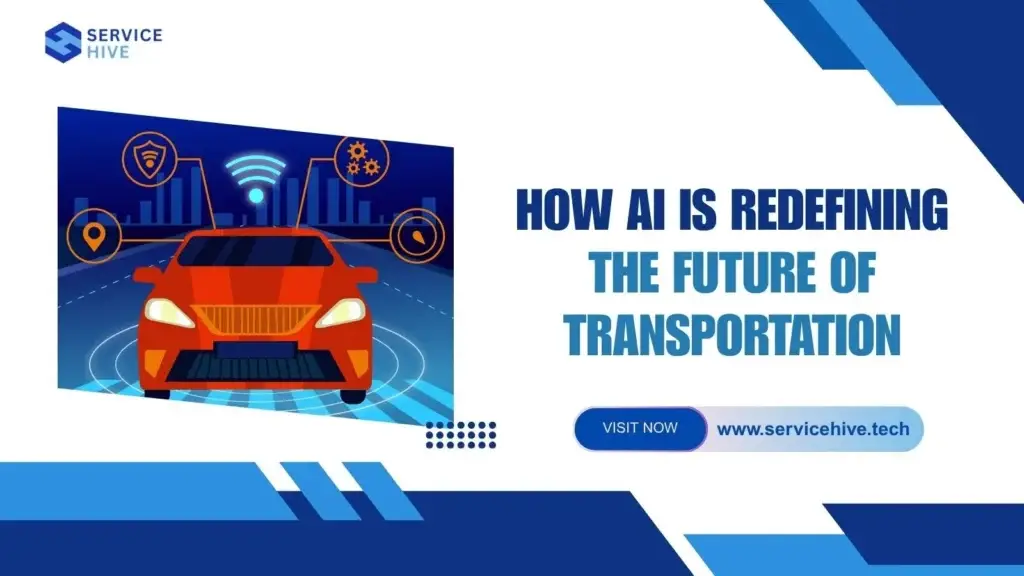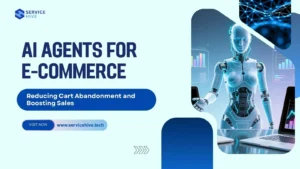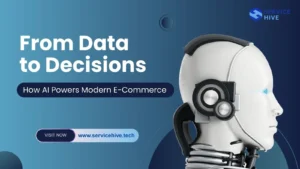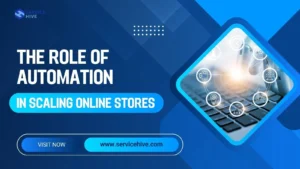
Why E-Commerce Brands Partner with Service Hive for AI-Powered Growth
Why E-Commerce Brands Partner with Service Hive for AI-Powered Growth Adopting AI inside a business often feels exciting and intimidating

Introduction
The transportation industry is undergoing a major transformation — and Artificial Intelligence (AI) is leading the way.
From self-driving vehicles to intelligent traffic systems and predictive maintenance, AI is helping logistics companies, public transport networks, and manufacturers create safer, faster, and more efficient systems.
At Service Hive, we’ve worked with businesses to integrate AI-powered solutions that optimize fleet management, reduce downtime, and improve real-time decision-making. Let’s explore how AI is reshaping the transportation landscape in 2025 and beyond.
Table of Contents
What is AI in Transportation?
AI in transportation refers to the use of machine learning (ML), computer vision, and predictive analytics to enhance decision-making, automate processes, and improve operational efficiency.
It empowers systems to:
This isn’t just futuristic tech — it’s happening now. Companies worldwide are already using AI to handle fleet management, driver assistance, and automated navigation.
Key Applications of AI in the Transport Industry
AI enables vehicles to sense their surroundings, make driving decisions, and navigate complex routes with minimal human input.
Companies like Tesla, Waymo, and Volvo are pioneering this shift, using AI models to process data from sensors and cameras in real-time.
Instead of waiting for vehicles to break down, AI predicts failures before they happen. This allows companies to schedule repairs proactively, reducing downtime and costs.
Cities like Singapore and Amsterdam use AI-driven systems to control traffic signals based on real-time congestion data. This results in smoother traffic flow and reduced emissions.
AI algorithms analyze delivery routes, fuel consumption, and load distribution to create efficient logistics operations — saving both time and resources.
Benefits of AI-Powered Transportation
|
Real-World Examples of AI in Action
These innovations prove that AI isn’t replacing humans — it’s empowering them with better tools to make transport smarter and more reliable.
While AI in transportation offers massive benefits, adoption comes with challenges:
However, with the rise of AI-as-a-Service (AIaaS) and edge computing, implementation is becoming more accessible for mid-sized companies too.
According to McKinsey & Company, AI could help the global transport and logistics industry save $400 billion annually through automation and predictive analytics.
How Service Hive Supports Transportation Transformation
At Service Hive, we help transportation and logistics companies adopt AI-driven solutions tailored to their specific needs.
Our expertise includes:
We don’t just integrate technology — we align it with your business goals, ensuring measurable ROI.
Explore our AI Consulting for Transportation:
Service Hive – AI & Automation Solutions
For deeper reading on AI in transportation, explore:
Frequently Asked Questions (FAQs)
AI is used for route optimization, autonomous driving, predictive maintenance, and real-time traffic management across public and private transport sectors.
AI agents are digital systems that automate complex tasks — like route planning or fleet monitoring — to enhance operational efficiency and reduce human workload.
AI enhances safety through driver-assistance systems, predictive alerts, and automated braking — reducing the risk of human error.
Sectors like logistics, manufacturing, ride-sharing, and smart cities benefit the most through automation and real-time insights.
Service Hive specializes in AI consulting and automation solutions, helping companies design, deploy, and scale AI systems for improved safety, performance, and cost efficiency.
Conclusion
AI is no longer a futuristic concept in transportation — it’s the engine driving efficiency, safety, and sustainability.
Businesses that embrace AI now will lead the next wave of intelligent mobility.
If your organization is ready to integrate AI agents, predictive analytics, or automation, Service Hive is here to help you turn innovation into measurable results.

Why E-Commerce Brands Partner with Service Hive for AI-Powered Growth Adopting AI inside a business often feels exciting and intimidating

Service Hive’s AI Marketing Solutions for Online Brands Marketing used to be about creativity and timing. Today, it’s also about

Customer Behaviour Analytics: Turning Browsers into Buyers Customers browse, pause, scroll, compare — and then disappear. Not because they’re uninterested,

AI Agents for E-Commerce: Reducing Cart Abandonment and Boosting Sales Cart abandonment is one of the most frustrating problems in

From Data to Decisions: How AI Powers Modern E-Commerce E-commerce today isn’t short on data. Every click, scroll, cart action,

The Role of Automation in Scaling Online Stores Running an online store feels easy at the start—few orders, simple inventory,